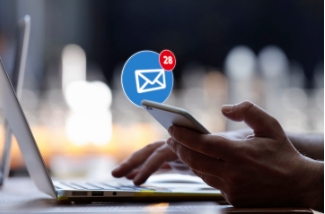Email newsletters still matter. Here’s how to make them work.
Search engine optimization, pay per click, content marketing, conversion rate, sales funnel . . . In the noisy world of digital marketing, it’s easy to get confused and overwhelmed with how to best grow your business.
One underrated marketing strategy? The good, old-fashioned email newsletter.
Yes, everyone’s inbox is bursting. But email newsletters are different. They aren’t unsolicited pieces of content. People who are on your mailing list have opted into your company in some way.
They’ve essentially told you: “I’m interested in what you have to offer. Tell me more.”
Plus, they’ve given you one of the most valuable pieces of information you can have as a business owner: their email address.
Email newsletters aren’t created equally, though. Some newsletters generate calls and emails; others generate an avalanche of unsubscribes.
There is indeed an art to writing a great email newsletter. Read on to get the most out of your efforts.
Keep It Simple
From the actual copy to the images and white space, email newsletters need to be simple, lightweight and easy to read quickly. Be sure to:
- Keep sentences short and active. Check out online tools such as the Hemingway Editor and Readable.io.
- Incorporate white space. Forget what your 8th grade English teacher told you (sorry, Mrs. Buchanan). Online reading isn’t the same as print reading. Bullet points are your friend. One to three sentences per paragraph is the sweet spot. Don’t be afraid to even have a one-word paragraph.
Boom!
- Don’t overwhelm with images. Large and/or too many Images can slow load time. Some recipients may even have images turned off or be receiving text-only emails. Keep pictures small in size and number.
- Be brief. There’s no hard rule on how long an email newsletter should be, but if you’re going over 800 words, consider posting it to your blog instead.
Related: 6 Top Marketing Strategies to Generate Online Leads
Avoid a Hard Sell
We get it. The temptation to pitch your services is great. But we’re here to tell you: Don’t do it!
This isn’t a coupon or an ad. The newsletter is a place to talk about what your business and customers care about.
Have an opinion. Tell a story. Share your expertise. Answer questions. Wish them a happy holiday. But don’t push your services.
Does that mean you can’t include a call to action or some other type of sales tactic? Of course not! The rule of thumb is to balance 90% content with 10% sales.
Nail the Subject Line
It’s the greatest mystery of email campaigns: How do you get the recipient to open the email instead of sending it straight to the trash?
It all starts with the perfect subject line.
A great subject line is highly clickable without being too gimmicky or clever, and it needs to match the content of the newsletter to avoid a bunch of opt-outs. Subject lines also need to be short (approximately 50 characters).
A few ideas to get you started:
- Lists: “8 Things I Learned From Booking a Cheap Hotel”
- Instruction: “I’m Here to Change the Way You Buy Groceries”
- Company news: “How Our Company Celebrated Women’s History Month”
- Helpful information: “How and When to Visit Our U-pick Farm”
- Q&A: “3 Common Questions About Hot Stone Massage”
- Curiosity: “How Much House Can You Really Afford?”
Related: Non-Writer’s Guide to Writing for the Web
Optimize Your Timing
A great newsletter sent at the wrong time of day can be a big dud.
While the best time will differ depending on your product and industry, it’s helpful to remember that people check their personal email most frequently during pre-work hours (6 am - 8 am), midday (think lunch break) and evenings (8-11 pm).
Also, keep reader demographics in mind. If your readers are largely retirees, a late-night send time probably isn’t optimal. If they’re mostly Millennials, then late night might work great.
Send Regularly
How much is too much for email newsletters?
More than once a week is spammy. Less than once a month isn’t enough and may, in fact, trigger more opt-outs since your business or brand isn’t front-of-mind.
If you’re just getting started with newsletters, commit to every two-three weeks. To streamline the process, try repurposing blog posts or writing a Q&A or FAQ, both of which are fairly easy to pull together (and even break out into dedicated newsletters for each question).
Edit and Test (A Lot!)
The thing about email is that once it’s out there, it’s out of your hands. A typo can’t be fixed. A broken link can’t be corrected. The wrong photo can’t be swapped out.
Whether you’re a wordsmith or a grammar flunkie, here’s how to avoid the embarrassment of email errors:
- Type your newsletter into a Google or Word doc first. Use a spelling and grammar checker. Also install a grammar editor (Grammarly is a popular one, available for your browser, Google Docs, and Word). This will catch nearly all errors.
- Paste your text into a readability editor to revise clunky sentences.
- Have at least two other people read your copy carefully and slowly.
- Send yourself and other friends a test email.
- Check the email design on your desktop, a tablet, and your smartphone. Make sure it displays correctly on all three environments.
Getting Started
Successful email newsletters take some trial and error. As you send out quality content, you’ll be able to see what works and what’s falling flat by looking at hard data (number of opens, click-throughs and unsubscribes) as well as nuanced details (such as the wording of the subject line or number of images).
Need some help getting started with your email marketing? Integritive works with businesses of all sizes in a variety of industries to get the most out of their digital marketing efforts. To learn more, send us — what else? — an email!






